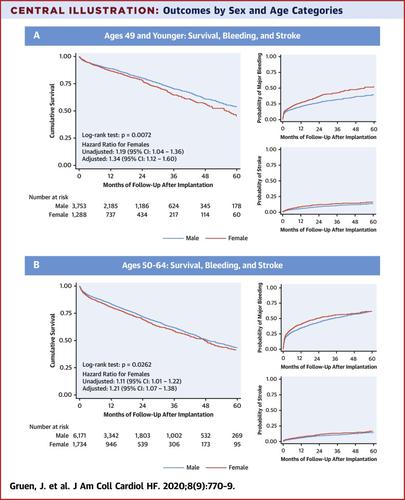JACC: Heart Failure ( IF 13.0 ) Pub Date : 2020-07-08 , DOI: 10.1016/j.jchf.2020.04.015 Jadry Gruen 1 , Cesar Caraballo 2 , P Elliott Miller 3 , Megan McCullough 1 , Catherine Mezzacappa 1 , Neal Ravindra 4 , Clancy W Mullan 5 , Samuel W Reinhardt 6 , Makoto Mori 7 , Eric Velazquez 6 , Arnar Geirsson 5 , Tariq Ahmad 8 , Nihar R Desai 8

|
Objectives
This study sought to use INTERMACS (Interagency Registry for Mechanically Assisted Circulatory Support) results to evaluate sex differences in the use and clinical outcomes of left ventricular assist devices (LVAD).
Background
Despite a similar incidence of heart failure in men and women, prior studies have highlighted potential underuse of LVADs in women, and studies of clinical outcomes have yielded conflicting results.
Methods
Patients were enrolled from the INTERMACS study who underwent implantation of their first continuous-flow LVAD between 2008 and 2017, and survival analyses stratified by sex were conducted.
Results
Among the 18,868 patients, 3,984 (21.1%) were women. At 1 year, women were less likely to undergo heart transplantation than men (17.9% vs. 20.0%, respectively; p = 0.003). After multivariable adjustments, women had a higher risk of death (hazard ratio [HR]: 1.15; 95% confidence interval [CI]: 1.07 to 1.23; p < 0.001) and were more likely to incur post-implantation adverse events, including rehospitalization, bleeding, stroke, and pump thrombosis or device malfunction. Although women younger than 50 years of age had an increased risk of death compared to men of the same age (HR: 1.34; 95% CI: 1.12 to 1.6), men and women 65 years of age and older had a similar risk of death (HR: 1.09; 95% CI: 0.95 to 1.24).
Conclusions
This study found that women had a higher risk of mortality and adverse events after LVAD. Only 1 in 5 LVADs were implanted in women, and women were less likely to receive a heart transplant than men. Further investigation is needed to understand the causes of adverse events and potential underuse of advanced treatment options in women.
中文翻译:

接受左心室辅助装置治疗终末期心力衰竭的患者的性别差异。
目标
本研究试图使用 INTERMACS(机械辅助循环支持机构间注册)结果来评估左心室辅助装置 (LVAD) 使用和临床结果的性别差异。
背景
尽管男性和女性的心力衰竭发生率相似,但先前的研究已经强调了女性 LVAD 的潜在使用不足,并且临床结果的研究产生了相互矛盾的结果。
方法
从 INTERMACS 研究中招募了在 2008 年至 2017 年间接受首次连续流 LVAD 植入的患者,并进行了按性别分层的生存分析。
结果
在 18,868 名患者中,3,984 名 (21.1%) 为女性。1 年时,女性接受心脏移植的可能性低于男性(分别为 17.9% 和 20.0%;p = 0.003)。多变量调整后,女性的死亡风险更高(风险比 [HR]:1.15;95% 置信区间 [CI]:1.07 至 1.23;p < 0.001)并且更有可能发生植入后不良事件,包括再住院、出血、中风和泵血栓形成或设备故障。尽管与同龄男性相比,50 岁以下女性的死亡风险增加(HR:1.34;95% CI:1.12 至 1.6),但 65 岁及以上的男性和女性的死亡风险相似(HR:1.09;95% CI:0.95 至 1.24)。
结论
该研究发现,女性在 LVAD 后死亡和不良事件的风险更高。只有五分之一的 LVAD 植入女性体内,女性接受心脏移植的可能性低于男性。需要进一步调查以了解不良事件的原因以及女性高级治疗方案的潜在使用不足。



























 京公网安备 11010802027423号
京公网安备 11010802027423号